The world of marketing is changing fast. It seems like the strategies companies employ to dominate their categories are continuously evolving and as a smart mobile marketer you have to stay on top of your game.
One of the most important developments of the past years is the shift from funnel-thinking to growth-loop thinking.
This definitive guide (which will be updated regularly), will cover all modern mobile growth loops that the best mobile brands employ today, both apps and games, to reach global success and dominate their categories.
You can and should view this as a type of growth menu. As a person in charge of growing a mobile application, a great growth strategy will usually involve a combination of one or more of these growth loops.
What is the mobile growth loop?
The traditional funnel has a core problem that separates successful apps from unsuccessful ones. The problem lies with the fact that the mobile marketing funnel is inherently one-sided.
You put in some effort at the top, driving awareness to your app, and get some percent of the top-of-funnel exposed users as installs, and then a percentage of those installs as high LTV retained app users.
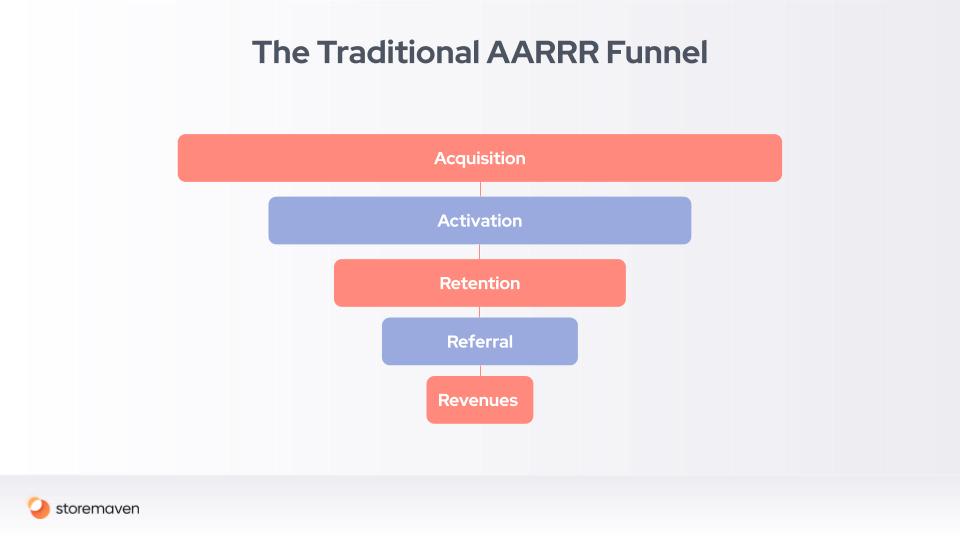
There is nothing in this traditional view of growth that connects the output of the model (an install, a retained user, or a paying user) with the input it needs to generate an additional user.
A growth loop is, as the name suggests, a closed system where the input, through a series of steps, generates an output that is naturally re-invested as the input of the next cycle of the loop.
Let’s take the most classical growth loop, user-invites, or known by its other name, a personal viral loop.
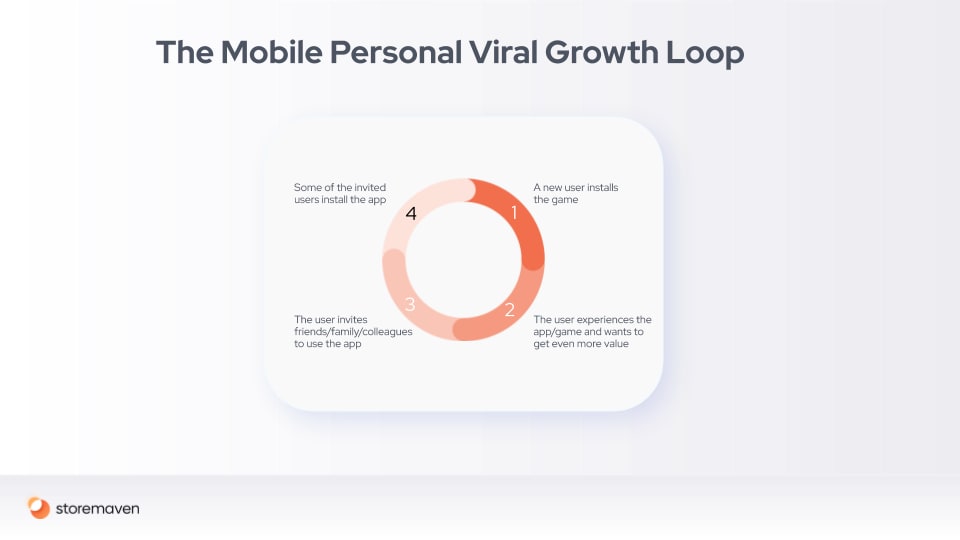
The steps in the mobile personal-viral growth loop:
- A user installs the app and uses it.
- Given the user has enough motivation to do so, they invite X amount of friends to install the app.
- A certain percentage of the invited users accept the invite, and install the app.
Let’s say that a user invites on average five additional users, and 40% of these invites convert into new installs. In the next cycle of the loop, two users will be the input to the next cycle, which will create four new installs in the next cycle and so forth.
What are the components of a mobile growth loop?
The involved parties
In each growth loop, there are one or more involved parties. Usually they fall into the categories of:
- Value Receiver – the party that receives value
- Value Generator – the party that generates value
- Value Distributor – the party that distributes value
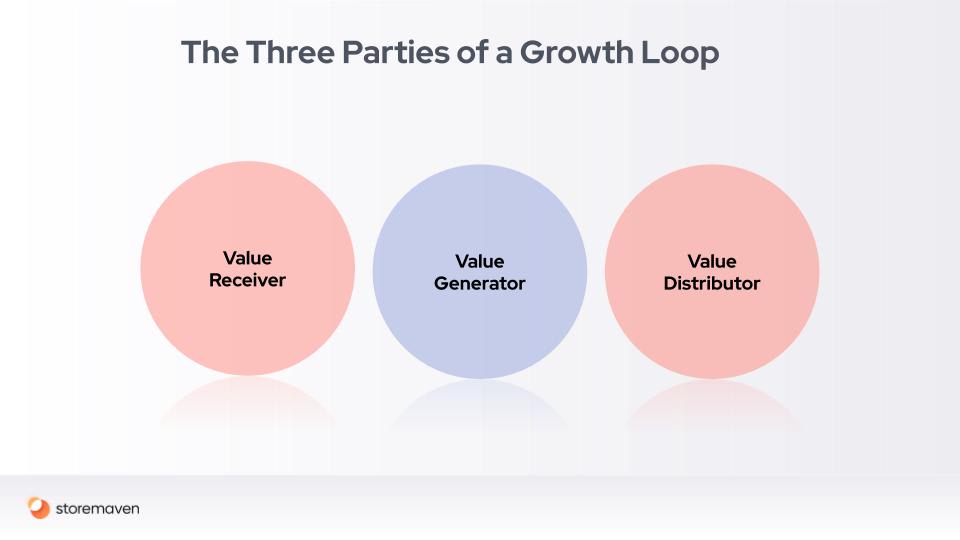
The motivations
What’s behind the “Why” for someone to perform the next action in the loop? In the example we outlined above, why should a user want to invite new users? Why would a user accept such an invite? Here are some common reasons:
- Personal – by distributing the value I improve my personal experience. It makes the app or game better for me.
- Social – by distributing the value I increase my own social capital.
- Financial – by distributing the value I get paid.
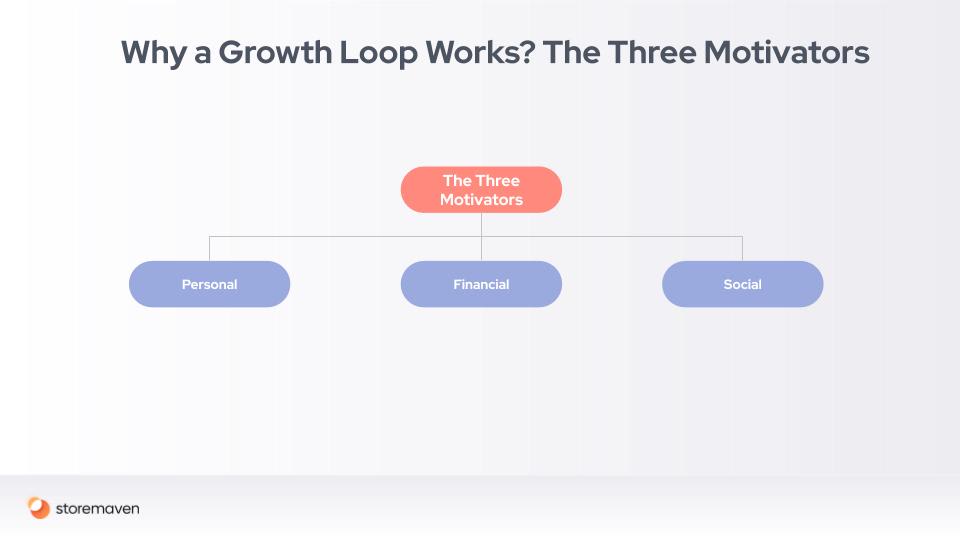
The metrics
Each value also has a series of metrics that govern how well it’ll produce growth:
- How fast can the growth loop complete a cycle?
- How fast the growth loop will exhaust itself?
- How much investment is required to get the loop spinning in the first place?
- How high/low are the conversion rates between steps in the loop?
In our example, the user-invite personal viral loop, these components will look somewhat like this:
| Involved parties | Who is it? | Motivation |
| Value Receiver | Invited users (friends) | Play a new game with my friends, or discover a new app my friends recommend |
| Value generator | An app user | Play the game or use the app in a way that generates value for the user |
| Value distributor | An app user | Either win a certain in-app reward, financial or other in-app value, increase their social capital (“I discovered a really cool app”), or make the app experience better for themselves |
And the metrics would look something like this:
| The metric | Depends on |
| How fast can the growth loop complete a cycle? | How fast you can get a user to generate value with the app, to the point they’ll agree to invite their friends. |
| How fast the growth loop will exhaust itself? | How concentrated the audience is, in some cases, a group of friends will all invite one another and they’ll run out of new people to invite. |
| How much investment is required to get the loop spinning in the first place? | Your ability to create the invite mechanics within the app as relatively straightforward and has a large enough user base to begin with to get meaningful figures. |
| How high/low the conversion rates between steps in the loop? | How good the experience is for an app user and what’s the motivation behind inviting new users to the app. |
The difference between micro and macro mobile growth loops
A mobile app growth strategy would consist of one or more micro growth loops and for the most successful apps out there, it’ll also include a macro growth loop that strengthens the other micro-loops and helps them to output even more growth.
A personal viral loop is a micro growth loop. But it can be improved by a macro growth loop enhancing it.
Take Airbnb for example. They had a robust personal viral loop (based on financial motivations, you get a referral fee for successful invites as a host). But the conversion rates of this loop: what is the percentage of users that’ll receive the invite and become hosts for example is governed by another principle.
The more demand that exists on the Airbnb platform, the more valuable it’ll be for a potential host to go through the hassle to actually become one.
So a cross-side network effect macro loop was also in play here.
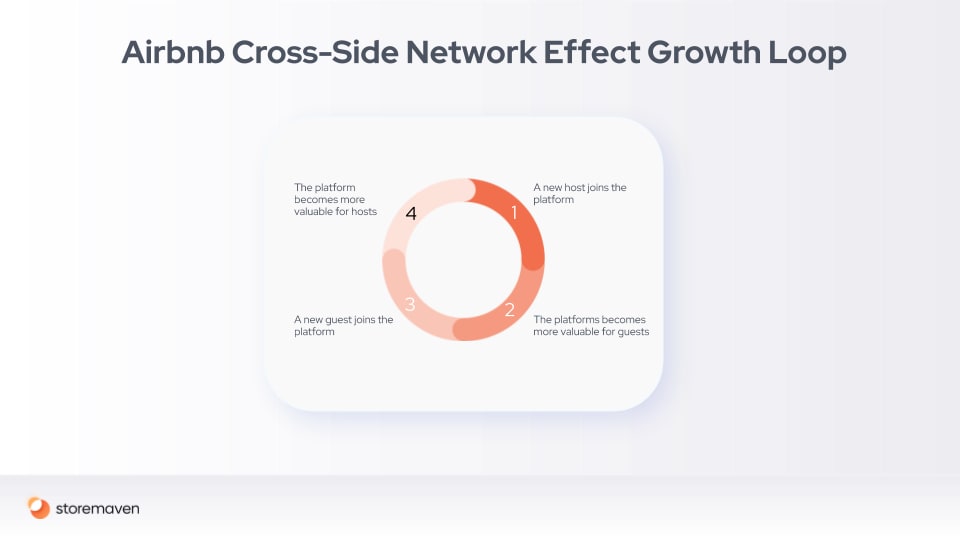
The more users they have on the platform, the more value will exist to the supply side, and the more supply that they’ll have, the more value that’ll exist for users.
So as the cross-side network effect will be in play, it’ll impact the micro growth loop of the personal viral loop.
The probability a user will accept an invitation to become a host increases as the more users there are looking for a place to stay in that city, which means the more the Cross-Side network effect loop spins, the higher the conversion rate from invite -> host will be.
Think of macro loops as tectonic shifts in the economics of your business that can impact the individual mechanisms driving your growth.
Why do mobile growth loops lead to sustainable growth vs. the traditional funnel?
Your job is to produce growth for your product and company. Think about it philosophically for a minute. Assuming that the product you have can deliver value to your audience, it is your job to get them to experience that value as fast and as widely as possible.
Imagine a traditional content funnel. The upside-down pyramid we shared above.
When your growth is based on a funnel such as the one above, there is no clear relationship between how the output of new users is re-invested through certain processes to generate other users. This usually leads to linear growth that dies out after a while.
That’s not the fastest or widest way to get more of your audience to experience the value of your product, which means there is a better way to do your job.
To grow faster using a funnel, you usually throw in more resources at the top of the funnel: more people, money, and channels. The fact that you added a new channel or another person to the team doesn’t result in an output that creates compounding growth.
At some point, you run out of new resources to add to the top of the funnel and growth will stall, as opposed to a loop that creates compounding growth. This is not to say that growth loops don’t reach a certain potential at some point, but still, each cycle reinforces the next.
How the best mobile apps and games grow, a mobile growth menu
Let’s start breaking down our mobile growth “menu”.
Personal Viral Loop
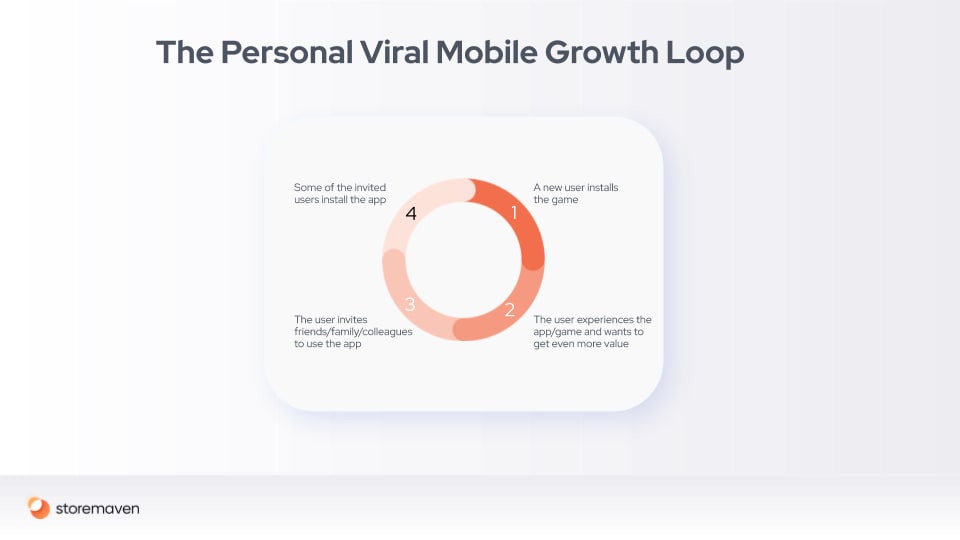
How it works:
Step 1 – A user installs the app and uses it.
Step 2 – Given the user has enough motivation to do so, they invite X amount of friends to install the app.
Step 3 – A certain percentage of the invited users accept the invite, and install the app.
Growth Loop Stakeholders
- Value Receiver – invited user
- Motivation: to discover a new app friends/family/colleagues are using or to play a game with them.
- Value Generator – an app user
- Motivation: to generate more value from the app.
- Value Distributor – an app user
- Motivation: if more of my friends/family/colleagues will be on the app it’ll give more value
- Metrics
- How fast can the growth loop complete a cycle?
- This loop is pretty fast, depending on when the user feels the need to invite more users to the app.
- How fast the growth loop will exhaust itself?
- Depends on how diverse your audience is. If you’re targeting specific college students, at some point that audience will have no new students to invite.
- How much investment is required to get the loop spinning in the first place?
- Relatively easy to implement with invite mechanics.
- How fast can the growth loop complete a cycle?
- Conversion Rates
This loop has quite a lot of “leakage” as there are a lot of users that don’t end up inviting anyone.
- From a new user to an “inviting” user – to improve this, make it clear to users as to why the app/game becomes much better with their family/friends/colleagues and improve onboarding.
- From an invite to “open” and “accept” – to improve this, increase brand awareness and capital, optimize the invite flow.
- How to use –
- First of all, understand if this loop is a good fit for your product. The main question that should guide you is: “Does the app become better with family/friends/colleagues on it? If not, this loop won’t work, as the value distributor won’t have enough value to actually send out the invites.
- Examples
- WhatsApp, Instagram, Snapchat, Venmo, Among Us, etc.
Financial Viral Loop
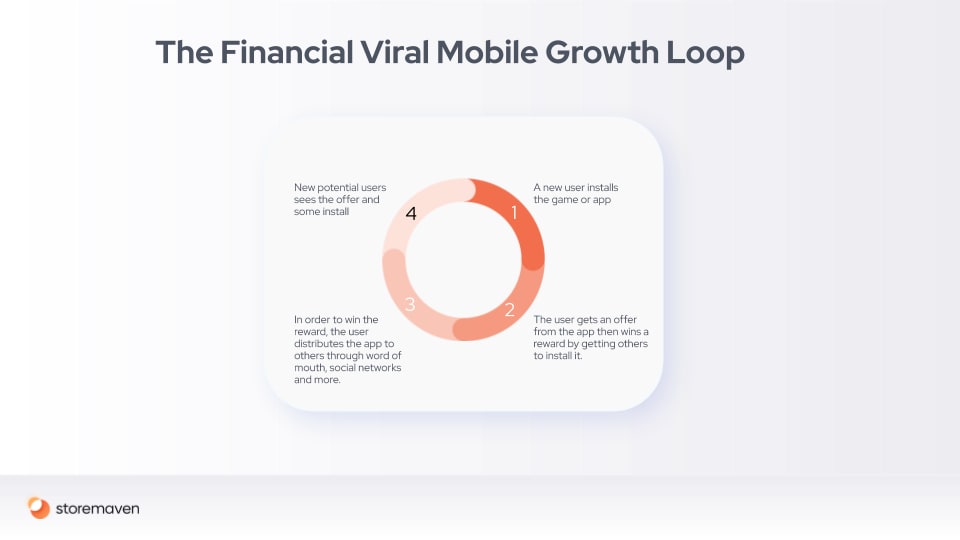
How it works:
Step 1: A user installs the app or game
Step 2: The user gets an offer from the app then wins a reward by getting others to install it.
Step 3: In order to win the reward, the user distributes the app to others (and potentially a reward for the new user that installs the app) through word of mouth, social networks and more.
Step 4: A new potential user sees the offer and installs the app or game.
Growth Loop Stakeholders
- Value Receiver – invited user
- Motivation: to receive some sort of reward by installing the app (i.e. get a free stock when you join Robinhood)
- Value Generator – the company (offering a reward for invites)
- Motivation: to get more users by offering them a reward
- Value Distributor – an app user
- Motivation: to get the financial reward for the invite (i.e. get a free stock when you join Robinhood).
- Metrics
- How fast can the growth loop complete a cycle?
- This depends on the reward budget and how fast you recoup the reward, this loop can slow down due to limited reward resources.
- How fast the growth loop will exhaust itself?
- This loop can run very long-term, as long as giving out the reward is ROI positive and the time to recoup the investment (so you can fund another reward) is short enough. If it’s not, this loop can very quickly bankrupt a company if not stopped.
- How much investment is required to get the loop spinning in the first place?
- Relatively high as you need to fund the rewards, and for a high-scale app it can reach hundreds of thousands of dollars, or even millions.
- How fast can the growth loop complete a cycle?
- Conversion Rates
- From a new user to an “inviting” user – to improve this, make the financial reward crystal clear to the user, improve the reward, and improve onboarding.
- From an invite to “open” and “accept” – to improve this, increase brand awareness and capital, optimize the invite flow including the way you convey the value of the reward.
- How to use –
- First of all, put together a financial plan and budget for the reward, run many tests to confirm you’re able to recoup the investment fast enough. Then run experiments to discover the most effective reward. In the case of Robinhood, they used specific stock names (not just a random stock) that you might get (Groupon, Facebook, etc.).
- Examples
- Robinhood, Uber, Wolt, Bird, etc.
Social Viral Loop
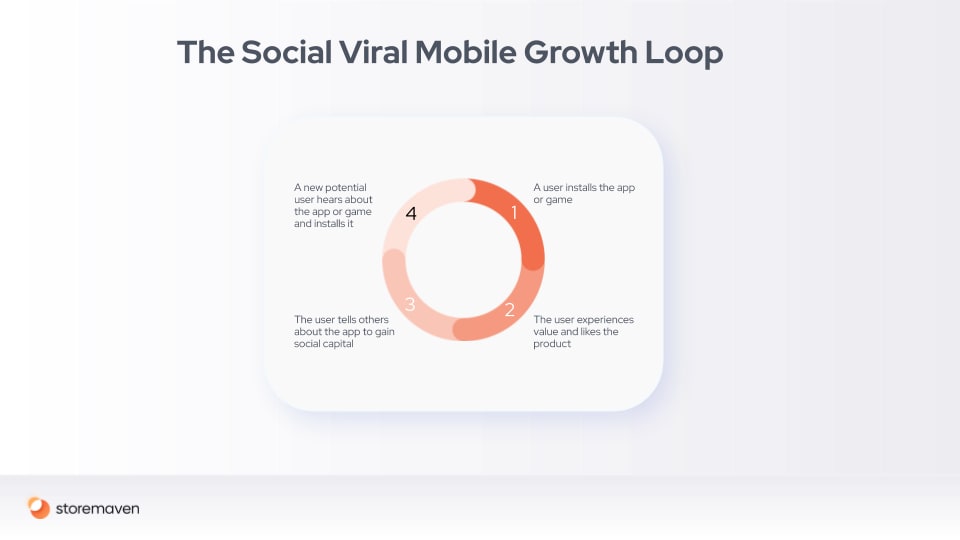
How it works:
Step 1: A user installs the app or game.
Step 2: The user experiences value and likes the product.
Step 3: The user tells others about the app to gain social capital (be perceived as the person that brought a cool new product to the attention of a friend/colleague/family).
Step 4: A new potential user hears about the app or game and installs it.
Growth Loop Stakeholders
- Value Receiver – New App User
- Motivation: to discover a new app/game that’ll provide me with value.
- Value Generator – Existing App User
- Motivation: to experience the app and generate value to myself.
- Value Distributor – Existing app user
- Motivation: to increase my social capital by telling others about it.
- Metrics
- How fast can the growth loop complete a cycle?
- This loop is usually long as it takes a long time for the user to actually meet the people they want to introduce to the app, or have the relevant conversations to bring it up (i.e. a water cooler conversation about new games folks play).
- How fast the growth loop will exhaust itself?
- This loop can go on for a very long time as long as users get a great experience using it.
- How much investment is required to get the loop spinning in the first place?
- No investments at all besides making sure users get a great experience by using the app. That said, the better the brand power of the app, the more likely the user will be motivated to talk about it, as people want to be perceived as those that introduced their social circles to new cool apps and games.
- How fast can the growth loop complete a cycle?
- Conversion Rates
- From a new user to a “WOM” user – To improve this, you need to invest in making sure users have a great experience using the app as well as investing in PR and making sure the app is perceived as innovative, “cool” and a product people actually want to talk about with their friends.
- From a WOM to install – The better the brand value the better the chances are that the person hearing about the app already heard about it before, hence they’re more likely to convert to an install.
- How to use –
- There is no very direct way to influence word of mouth. This loop is usually a side-effect of great brand capital and PR, and world-class experience for users of the app/game.
- Examples
- Among us, Zoom, Bird.
App Store Growth Loop
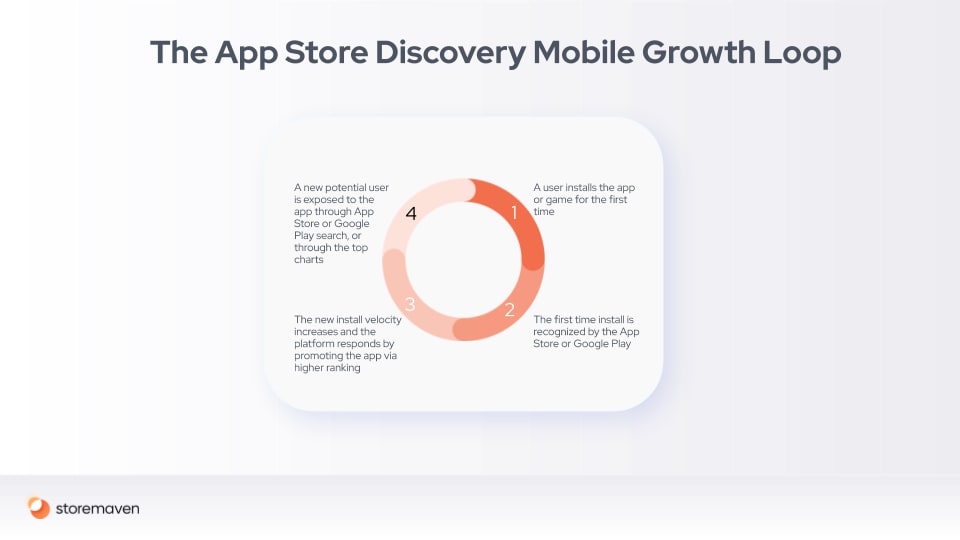
How it works:
Step 1: A user installs the app or game for the first time.
Step 2: The first time install is recognized by the App Store or Google Play.
Step 3: The new install velocity increases and the platform responds by promoting the app via higher top/category charts as well as keyword ranking.
Step 4: A new potential user is exposed to the app through App Store or Google Play search, or through the top charts, and installs the app or game.
Growth Loop Stakeholders
- Value Receiver – New App User
- Motivation: to discover a new app/game that’ll provide me with value.
- Value Generator – The app store
- Motivation: to generate a metric that’ll help recognize popular apps and games.
- Value Distributor – The app stores
- Motivation: To provide the best experience for app store users by surfacing great apps with the best user experience.
- Metrics
- How fast can the growth loop complete a cycle?
- Pretty fast, the install velocity metric is updated in a matter of days.
- How fast the growth loop will exhaust itself?
- As long as there is more supply of users installing for the first time. In order to work efficiently this loop needs to latch onto other loops (such as a paid ad loop) to provide more “fuel”. When you no longer tap into new audiences this loop will exhaust itself.
- How much investment is required to get the loop spinning in the first place?
- In order to get started, this loop requires a substantial amount of first time installs, which usually come through paid ads, making it a mid to high investment cost to get it started. Once the loop is in play and the app/game ranks high, it compounds itself.
- How fast can the growth loop complete a cycle?
- Conversion Rates
- The percent of new users impressions to first-time installs out of all installs – As the app stores treat first-time installs as a top proxy for popularity, it’s crucial to drive first time installs to increase the new install velocity. This is governed by the conversion rate from a new user impression to install (through a paid ad or organically in the app store). Improve this experiment with ad and app store creatives to appeal to new users and increase first-time install conversion rates.
- The percent of Browse or Explore / Search users that install – For the loop to close, a user browsing or searching the app store and getting exposed to an app/game listing has to convert. To improve this, experiment with app store creatives to drive first-time install conversion rates.
- How to use –
- This loop is usually bootstrapped through driving a meaningful volume of first-time installs, usually done through paid user acquisition of new users.
- Examples
- Most top apps/games dominate the top charts.
User Generated – User Distributed content loop
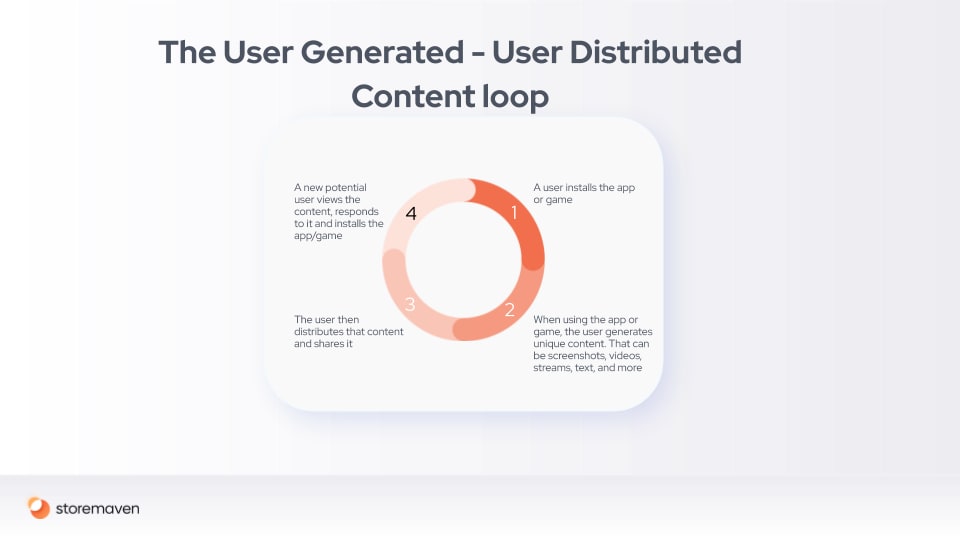
How it works:
Step 1: A user installs the app or game.
Step 2: When using the app or game, the user generates unique content. That can be screenshots, videos, streams, text, and more.
Step 3: The user then distributes that content and shares it.
Step 4: A new potential user views the content, responds to it and installs the app/game.
Growth Loop Stakeholders
- Value Receiver – New App User
- Motivation: to discover a new app/game that’ll provide me with value.
- Value Generator – An existing app user
- Motivation: to use the app/game and get value out of it.
- Value Distributor – An existing app user
- Motivation: to increase the users’ social capital, or in some cases, financial motivations (true for streaming games).
- Metrics
- How fast can the growth loop complete a cycle?
- Pretty fast, the time it takes a user to use the app, generate the content and then distribute it, which many times happens immediately after generating the content.
- How fast the growth loop will exhaust itself?
- Usually tied to the popularity of the app. As users usually share the content for social capital reasons, once the app or game becomes outdated and stale, users will stop sharing its content.
- How much investment is required to get the loop spinning in the first place?
- Depends on the variation of the loop. If the way users distribute the content is through game streaming (on Twitch) for example, the game has to be cross-platform for it to work which means the investment is high. If it’s not being shared on streaming platforms but on social media platforms, the investment is basically in: brand and unique content. Making sure the game/app is popular enough and the content is unique itself so people perceive sharing it will increase their social capital. This is true for streaming purposes as well, the financial incentive to stream the game is stronger the more popular the game is (has a large enough audience).
- How fast can the growth loop complete a cycle?
- Conversion Rates
- The percent of new installs that generate content – to improve this, optimize the in-app flow that encourages users to generate unique content.
- The percent of content-generating-users that share the content – to improve this, optimize the in-app flow that encourages users to share the content through different platforms.
- The percent of users that were exposed to the shared content and installed the game – to improve this, make sure the distributed content clearly conveys to users which app/game it was made on and give them a clear way to find the app and install it themselves. Experiment with app store creatives that convey the sense of the “official” app that validates the fact they are installing the actual app that was used to generate the content they saw, as opposed to a copycat.
- How to use –
- If appropriate, invest in making sure users have enough motivation to generate unique content and share it. The users will distribute the content mostly for social capital motivations so they need to feel “cool” when sharing it.
- Examples
- FaceApp, Reface, Among Us.
The paid app growth loop
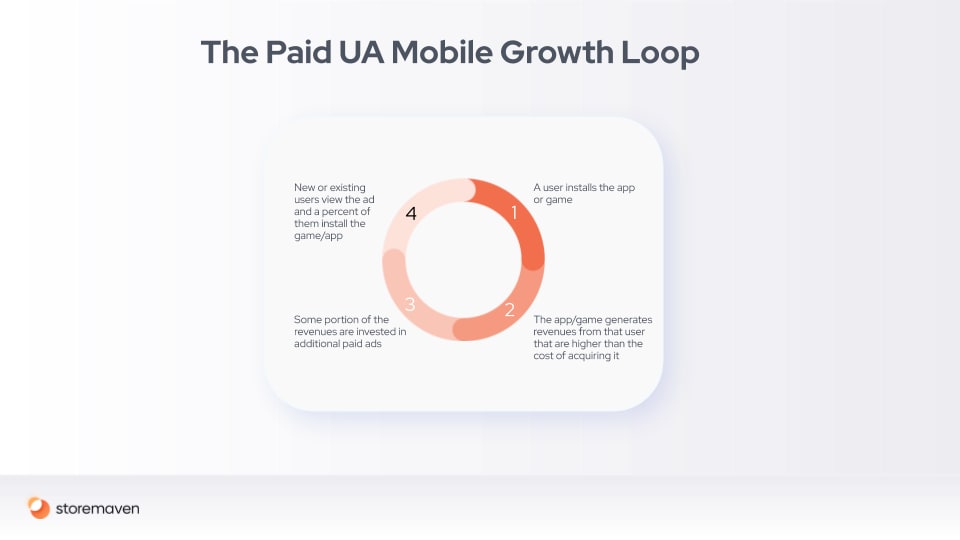
How it works:
Step 1: A user installs the app or game.
Step 2: The app/game generates revenues from that user that are higher than the cost of acquiring it.
Step 3: Some portion of the revenues are invested in additional paid ads.
Step 4: New or existing users view the ad and a percent of them install the game/app.
Growth Loop Stakeholders
- Value Receiver – New App User
- Motivation: to discover a new app/game that’ll provide me with value.
- Value Generator – The company
- Motivation: financial motivation, to increase the user base and to grow profitability.
- Value Distributor – The company
- Motivation: to expose as many qualified users to the ad by distributing it on ad networks.
- Metrics
- How fast can the growth loop complete a cycle?
- This is one of the fastest loops, as funds are recouped by acquired installs. They make in-app purchases or view ads within the app so they are immediately re-invested in more ads.
- How fast the growth loop will exhaust itself?
- Advertising to an existing audience can exhaust itself at some point (the time it actually takes for this to happen is dependent on the paid user acquisition budget), but for this growth loop to continue working, new audiences have to be tapped into.
- How much investment is required to get the loop spinning in the first place?
- Most ad networks allow flexible user acquisition budgets, but given the high competition on mobile ad impressions, driving up user acquisition costs and the cost per acquisition, to get meaningful traction an app/game needs to invest usually tens of thousands of dollars a month at a minimum. That said, this activity has to be managed so it usually requires building or hiring user acquisition managers to scale.
- How fast can the growth loop complete a cycle?
- Conversion Rates
- The percent of new installs that generate revenue – to improve this, optimize the in-app monetization mechanics. The more revenues a user generates and the faster it happens, the better the re-investment in new ads. When using ads that drive users with very low revenue-generating capabilities, the loop will dry up fast. This is also done by better targeting of ads to users with a high probability to become high LTV users.
- The percent of ad viewers that install the app/game – to improve this, experiment with both ad creatives and app store creatives to find the messaging and creatives that drive the most users from a specific channel to install. Use a platform such as Storemaven to generate these insights and drastically improve the performance of this loop.
- How to use –
- If appropriate, create a paid user acquisition budget, and if you don’t have a team then build a paid user acquisition team and start experimenting with different UA channels and targeting profiles to make the Return of ad spend (ROAS) make sense for the loop to spin profitably. If the economics of the loop won’t work, you’ll end up exhausting your resources which can become risky for the company. Many app companies were short-lived because of uncontrolled and unprofitable ad spend.
- Examples
- Most top app and game developers in the world, usually more game companies focus on this loop to grow.
Conclusion
This guide is meant as a map for mobile growth. We are attempting to study most, if not all, of the ways in which the most successful apps and games produce compounding growth that is x10, x100 and sometimes x1000 higher than their competitors.
This is done by them perfecting a growth loop they can also protect (it isn’t easily replicable, or requires significant investments to replicate).
We will update this guide on an ongoing basis to add more types of growth loops (many more coming so check it out soon), and also macro growth loops which contribute to the success of all other micro growth loops. You can use it as a map to:
- Map the current way in which your app grows.
- Identify blocks for growth by understanding why certain growth loops might stall (lack of motivation or lack of “fuel”).
- Plan your next growth strategies by identifying the most appropriate loop or loops and build them into your roadmap.
A great way to optimize many of these loops is to improve conversion rates from one step to another, by understanding the exact messaging and creatives you should use in the app stores and in your mobile install ads to “close the loop”. It happens to be that we have developed the world-leading platform for creative experimentation and you can check it out to build/improve or unblock your mobile growth loops.












